Some experts will tell you there are three golden rules to setting up a restaurant: location, location and location. Rita House gets one out of three for its dining establishment set up in the alleys behind the bustling Zhongxiao East Road shopping area.
Sandwiched between two "very, very good" restaurants (VVG Bistro and VVG Table), the owner who gives her name simply as Rita, has her work cut out to compete. Her place looks the part. Opened in July last year, it has a great deck with plenty of greenery and the surroundings are tranquil. Inside there is antique furniture, wooden paneling and an impressive bar at the back.
Even so, it's vaguely chintzy. Chandeliers and Tiffany lamps cast their spell and there are small pictures on the wall. It's as if the owner imagined what a classy European teahouse was like and came up with a gin palace instead. Ornate chairs jostle with empty bird cages and cabinets filled with tea containers. It's not unpleasant but it won't win any design awards.

PHOTO: JULES QUARTLY, TAIPEI TIMES
As for the food, some dishes are themed. This is a mistake. For example a Chopin steak (NT$600) competes with a "lovingly baked" Mozart pork chop (NT$580). What do Amadeus Mozart and pork, Frederic Chopin and beef, have in common? According to the menu, English-style lamb (NT$550) is "jolly good," but the house pasta with clams in tomato sauce is standard fare and quite expensive at NT$400.
There is a set lunch menu, however, that is good value. It started on a bum note with a few pieces of iceberg lettuce and four, black olive halves resting on cucumber slices, coated in a drizzled, orange-flavored mayonnaise. The heated roll that followed was better, as it had not been microwaved to death. The onion soup was homemade and therefore deserves some credit, but was a touch watery.
The main course of smoked chicken was flavorsome and tender, though it was swimming in a pool of oil. The risotto was small but perfectly formed, with golden needle and sliced field mushrooms, plus chopped tomatoes and a refreshing pesto sauce. The only gripe here was a sprig of parsley past its sell-by date. The lunch finished on a high note with a satisfying creme brulee and chamomile tea. Not bad for a total of NT$280.
Open from 11am to 10:30pm, Rita House provides lunch, dinner and a meeting place for tea sets in the afternoons. The owner encourages customers to take their time and the service was attentive.

Cheng Ching-hsiang (鄭青祥) turned a small triangle of concrete jammed between two old shops into a cool little bar called 9dimension. In front of the shop, a steampunk-like structure was welded by himself to serve as a booth where he prepares cocktails. “Yancheng used to be just old people,” he says, “but now young people are coming and creating the New Yancheng.” Around the corner, Yu Hsiu-jao (饒毓琇), opened Tiny Cafe. True to its name, it is the size of a cupboard and serves cold-brewed coffee. “Small shops are so special and have personality,” she says, “people come to Yancheng to find such treasures.” She

Late last month Philippines Foreign Affairs Secretary Theresa Lazaro told the Philippine Senate that the nation has sufficient funds to evacuate the nearly 170,000 Filipino residents in Taiwan, 84 percent of whom are migrant workers, in the event of war. Agencies have been exploring evacuation scenarios since early this year, she said. She also observed that since the Philippines has only limited ships, the government is consulting security agencies for alternatives. Filipinos are a distant third in overall migrant worker population. Indonesia has over 248,000 workers, followed by roughly 240,000 Vietnamese. It should be noted that there are another 170,000

Hannah Liao (廖宸萱) recalls the harassment she experienced on dating apps, an experience that left her frightened and disgusted. “I’ve tried some voice-based dating apps,” the 30-year-old says. “Right away, some guys would say things like, ‘Wanna talk dirty?’ or ‘Wanna suck my d**k?’” she says. Liao’s story is not unique. Ministry of Health and Welfare statistics show a more than 50 percent rise in sexual assault cases related to online encounters over the past five years. In 2023 alone, women comprised 7,698 of the 9,413 reported victims. Faced with a dating landscape that can feel more predatory than promising, many in

“This is one of those rare bits of TikTok fitness advice with a lot of truth behind it,” says Bethan Crouse, performance nutritionist at Loughborough University. “Sometimes it’s taken a bit too literally, though! You see people chugging protein drinks as they’re scanning out of their gym.” Crouse recommends the athletes she works with consume 20-30g of protein within 30-60 minutes of finishing a resistance training session. “The act of exercising our muscles increases the breakdown of muscle proteins,” she says. “In order to restore, or hopefully improve them — and get gains such as increased muscle mass or strength —